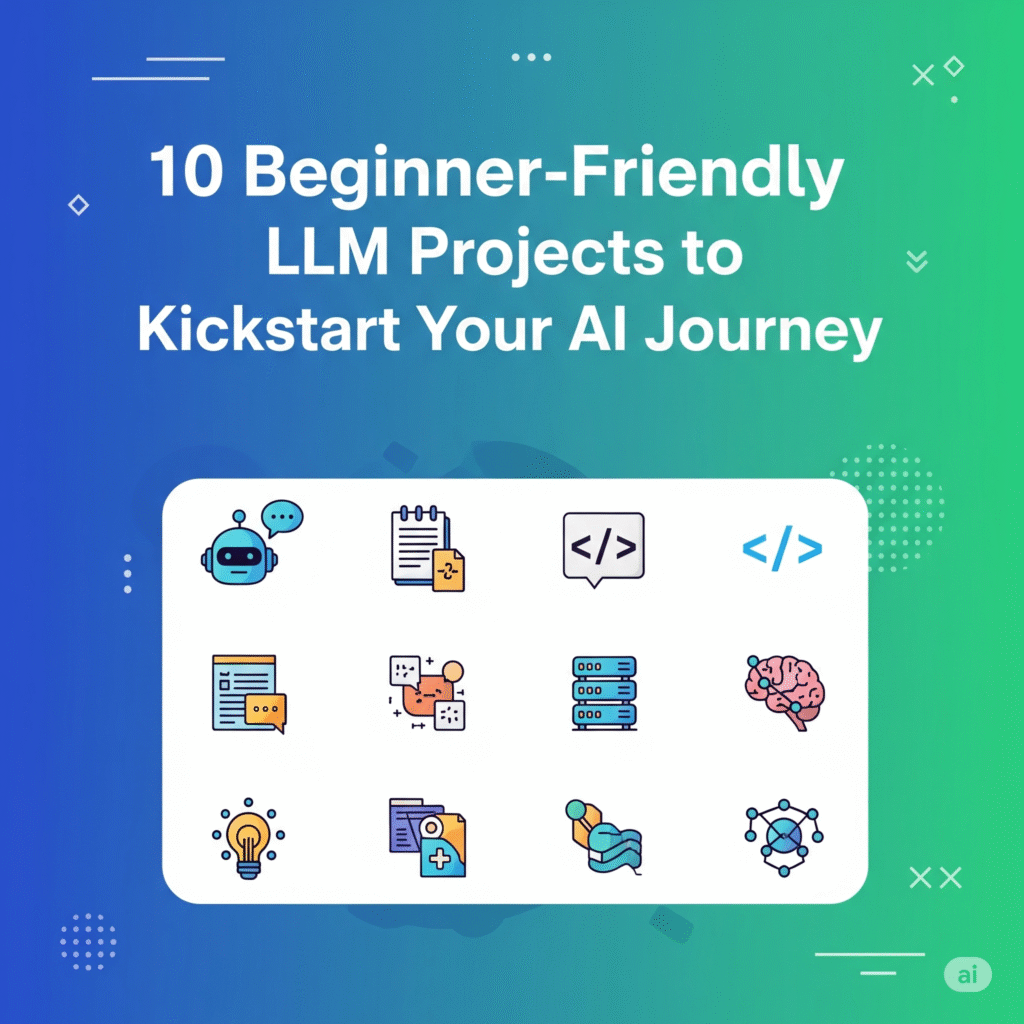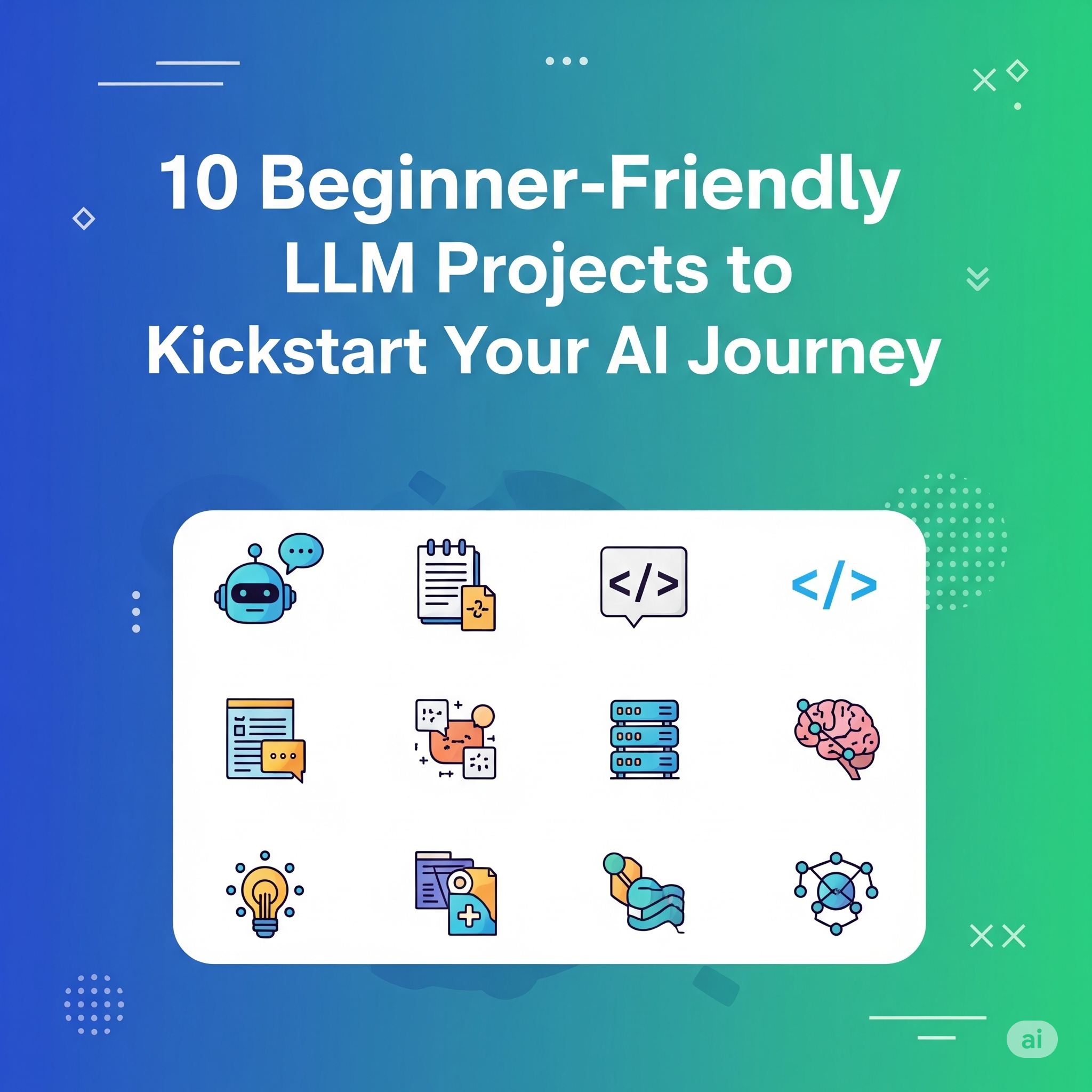Artificial Intelligence (AI) has moved from research labs into our daily lives, powering tools we use for work, study, and entertainment. At the heart of many modern AI applications are Large Language Models (LLMs) advanced algorithms capable of understanding, generating, and reasoning with human language.
Models like GPT-4, Claude, Mistral, and LLaMA can do everything from summarizing articles and answering complex questions to generating creative content and writing code. But reading about LLMs is one thing; building with them is where the real learning happens.

If you’re a beginner in AI or programming, practical projects are the fastest way to grasp how these models work. By experimenting with small, manageable applications, you’ll learn essential concepts like prompt engineering, embeddings, retrieval-augmented generation (RAG), and deployment all while creating tools that can be genuinely useful.
In this article, we’ll explore 10 beginner-friendly LLM projects you can start building today, along with ideas for tech stacks, skills you’ll gain, and real-world use cases.
Table of Contents
1. Custom Chatbot
A simple chatbot is one of the easiest ways to start working with LLMs. Your bot could answer customer questions, act as a personal tutor, or even serve as a productivity assistant.
- Tech Stack: OpenAI GPT-4 or Mistral API, LangChain for conversation memory, Streamlit/Flask for interface
- Skills Learned: Prompt design, session memory, API integration, basic UI development
- Example Use Cases:
- An academic tutor that explains concepts step-by-step
- A customer support bot for FAQs
- A personal assistant for scheduling and reminders
2. PDF Q&A Bot
Many businesses and students deal with lengthy PDFs that are hard to navigate. A PDF Q&A bot lets users upload a document and query it conversationally.
- Tech Stack: PyMuPDF or pdfplumber for text extraction, ChromaDB or FAISS for vector search, GPT-3.5/Claude for answer generation
- Skills Learned: RAG workflow, text chunking, vector embeddings, semantic search
- Example Use Cases:
- Lawyers querying legal contracts
- Students asking questions about research papers
- HR teams answering policy-related queries
3. YouTube Video Summarizer
Video content is everywhere, but finding the key points takes time. A YouTube summarizer extracts a video’s transcript and produces a short, informative summary.
- Tech Stack: youtube-transcript-api for captions, GPT for summarization
- Skills Learned: Working with external APIs, text preprocessing, summarization prompts
- Example Use Cases:
- Educational content reviews
- Quick recaps for news updates
- Research summaries for lectures
4. AI Email Assistant
Managing emails is time-consuming. An AI email assistant can summarize unread messages and even draft polite responses.
- Tech Stack: Gmail API, GPT-4/Claude, secure OAuth authentication
- Skills Learned: Integrating real-time data sources, secure API handling, contextual response generation
- Example Use Cases:
- Automating customer service inboxes
- Executive assistants for busy professionals
- Productivity tools for freelancers
5. Resume Analyzer with Feedback
This project analyzes a resume, identifies skill gaps, and suggests improvements to match job descriptions.
- Tech Stack: SpaCy or PyPDF2 for parsing, embeddings for similarity checking, GPT for recommendations
- Skills Learned: NLP preprocessing, job description parsing, data matching
- Example Use Cases:
- Job seekers improving resumes
- HR teams screening applicants
- Career counseling services
6. LLM Code Reviewer
Give your model a piece of code and get detailed feedback, optimization tips, or bug detection.
- Tech Stack: GPT-4, GitHub API for code fetching, Streamlit for UI
- Skills Learned: Technical prompting, code analysis, context optimization
- Example Use Cases:
- Developer productivity tools
- Coding education assistants
- Automated peer-review systems
7. SEO Blog Generator
Turn a topic into a search-optimized blog post complete with headings, keyword integration, and a call-to-action.
- Tech Stack: LLM for text generation, keyword planner APIs, Markdown/HTML export
- Skills Learned: SEO prompting, structured content generation, keyword placement
- Example Use Cases:
- Marketing teams scaling content
- Bloggers maintaining consistency
- Agencies creating client content quickly
8. Multi-Document Chat App
Instead of chatting with one document at a time, let users interact with multiple file types- PDFs, Word docs, and CSVs in a single session.
- Tech Stack: LlamaIndex, LangChain, FAISS/ChromaDB
- Skills Learned: Multi-source retrieval, document embeddings, advanced RAG pipelines
- Example Use Cases:
- Legal research across multiple case files
- Business analytics using CSV and PDF data
- Academic study tools
9. LinkedIn Post Generator
Turn bullet points into engaging, tone-matched LinkedIn posts for personal branding or marketing.
- Tech Stack: GPT or Claude, tone-specific prompt templates
- Skills Learned: Style transfer, tone adaptation, short-form writing
- Example Use Cases:
- Thought leadership content
- Corporate announcements
- Social media content automation
10. Telegram or WhatsApp AI Support Bot
Deploy an AI assistant directly into popular messaging platforms to automate conversations.
- Tech Stack: Telegram Bot API or Twilio WhatsApp API, GPT backend
- Skills Learned: Messaging API integration, real-time chat handling, intent recognition
- Example Use Cases:
- E-commerce customer support
- Service booking assistance
- Lead qualification
Experiment with Open-Source LLMs
If you want to avoid API costs or keep data private, try running models locally. Some great open-source options include:
- Mistral 7B – High speed, general-purpose model
- LLaMA 3 – Meta’s high-quality, open-weight model
- Phi-3 – Lightweight and efficient
- Zephyr – Instruction-tuned for better conversation
- Gemma – Google-backed, privacy-friendly
Use frameworks like Transformers, llama-cpp-python, or Ollama to run them on your own machine.
Conclusion: Learn by Doing, Not Just Reading
The fastest way to understand LLMs is by building real projects. Each of the ten ideas above offers a clear path to learning from basic prompt engineering to advanced RAG systems. By experimenting with these tools, you’ll gain the confidence and skills needed to create AI applications that solve real-world problems.
Whether your goal is to land a role in AI development, automate your workflow or launch a startup, these beginner-friendly projects are a perfect starting point. Remember, the AI field is evolving quickly, so hands-on experience will always set you apart.
So open your code editor, pick a project, and start building today — your journey into AI innovation begins now.
Related Reads
- LLM Agents: What They Are, How They Work, and Why They’re the Future of Autonomous AI
- 10 Free GitHub Repositories to Build a Career in AI Engineering
- Evaluating Large Language Models: Metrics, Best Practices and Challenges
- Synthetic Data in Machine Learning: Proven Benefits, Risks and Use Cases
- Simplifying the Mathematics of Neural Networks and Deep Learning
External Resources
Prompt Engineering Guide – https://www.promptingguide.ai
Full-Stack LLM Apps with Python – https://realpython.com
FAISS by Facebook AI – https://github.com/facebookresearch/faiss
Pinecone Vector Database – https://www.pinecone.io


5 thoughts on “Top10 Beginner-Friendly LLM Projects to Kickstart Your AI Journey”